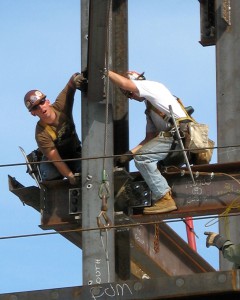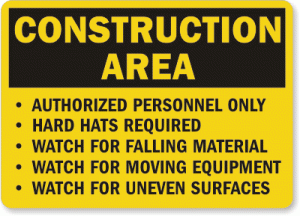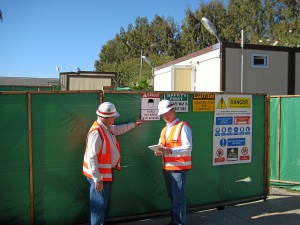Construction safety culture starts before work begins

The safety of workers several stories in the air has to start at ground level, a new report emphasizes. (Photo by Paul Keheler.)
Construction safety culture is a must for any company’s success and well-being. Construction is one of the most dangerous industries, simply due to the nature of the work. According to the Bureau of Labor Statistics, the field sees the second highest number of fatalities every year, ranking just behind transportation and warehousing.
Last week, ACE Construction, a property and casualty insurance provider, released a white paper that underscores the need for construction companies to build a foundation of safety culture before they even think about getting started on the foundation for a building.
The report, “Building a Proactive Safety Culture in the Construction Industry,” explains how construction companies can help save lives, reduce claims, enhance productivity and profitability and retain workers by “investing in a strong safety culture.
But how can a company develop a successful safety culture? Here are a few key recommendations from the report:
Start with pre-planning
The safety hazards for a project should be identified right from the start, alongside the means and methods of construction. This approach makes it easier to determine ways to minimize exposure to those risks and create a project-specific safety plan.
Screen subcontractor safety
While reviewing a subcontractor’s experience and referrals, companies should also look into safety indicators like lost-time incident rates, citation records from the Occupational Safety and Health Administration and the quality – or lack – of overall safety procedures.

Sure, hard hats are a must, but workers should understand what specific hazards they might encounter during a project. (Image via MySafetySign.com.)
Provide project-specific training
Safety training shouldn’t be reserved for new hires. Before work begins, companies should review the project-specific safety plan with workers, and hold a brief refresher on general safety requirements and expectations, including disciplinary actions, substance abuse testing and fall-management procedures.
Make it everyone’s job
All employees should feel responsible for promoting a safe work environment, starting from the top. “Chief executives should instill the idea in every level of management that the responsibility for safety lies with them,” the paper says.
For workers, this might mean helping them understand the vital role they play in identifying –and reporting – near-misses, substance abuse and unsafe conditions. It’s crucial to have a system in place that makes it easy and – if needed – anonymous to do so.
Make it personal
According to the paper, a “personal-based safety ideology” can be more effective than an “enforcement mentality.” In this approach, “employees are reminded, on a daily basis, of the impact that an injury can have on their home life and personal relationships.”

On-site safety managers and regular inspections should be a part of every construction project, no matter how small. (Photo by U.S. Army Corp of Engineers.)
Make it daily and continual
In addition to safety committees that include employees from all levels, companies should consider using on-site safety managers for all projects, no matter how small. This can help management receive real-time, real-world feedback on safety efforts.
Foremen should discuss safety hazards, concerns and controls with workers at the beginning of every shift, and ensure that they have the correct protective gear. Managers should also conduct periodic safety analyses as a project progresses.
As you create and refine your safety system, check out our free safety resources, like safety quizzes and printable safety signs.
Category: Construction, Safety Tips














